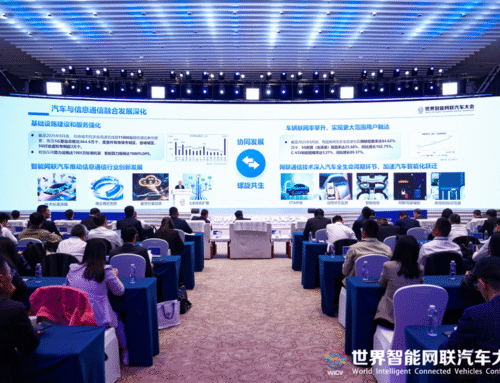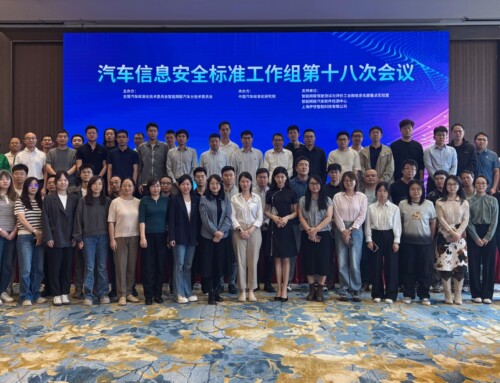On May 15, 2025, the Kick-off Meeting for National Standards on the Carbon Footprint of “New Three” Products, namely electric vehicles, lithium batteries and photovoltaic products, was held in Tianjin. Zheng Tianlei, Deputy Director of the China Automotive Standardization Research Institute (CASRI), attended and delivered remarks. Nearly 120 experts from Equipment Industry Development Center of the Ministry of Industry and Information Technology (MIIT), China National Institute of Standardization (CNIS), as well as domestic and international vehicle manufacturers, component suppliers, circular economy enterprises, testing organizations, research institutes, and universities participated in the meeting.
During the meeting, Mr. Zheng stated that under China’s dual-carbon strategy, which is carbon peak and carbon neutrality, the National Technical Committee of Auto Standardization (hosted by CATARC) has been putting efforts to systematically advance green and low-carbon automotive standards. Developing carbon footprint standards for the “New Three” products is well aligned with global trends and supports China’s national green development goals. It also serves as a key tool for driving the green and sustainable transformation of the industrial value chain. Mr. Zheng emphasized that moving forward, it will be essential to align standard development with industry needs, accelerate the formulation process, strengthen engagement with international research organizations, and promote mutual recognition of carbon footprint accounting rules between domestic and international systems.
Background of the Meeting:
CATARC launched the project of carbon footprint management standards system in 2021 and published the Roadmap for Standardization of Low-Carbon Development of China’s Automobile Industry (1.0) in 2023 which outlined the short-, medium- and long-term standardization plan. In December 2023, CATARC received approval to initiate two national standard-setting projects:
- 20232444-T-339 Road vehicle – General requirements for greehouse gas management – Part 1: Terms and definitions
- 20232445-T-339 Road vehicle – General requirements for greenhouse gas management – Part 2: Carbon footprint labels of road vehicle products
Both standards were approved in 2025 and are expected to be released soon.
Additionally, on December 31 2024, the National Standardization Committee (SAC) of China approved five more standard-setting projects proposed by CATARC.
| No. | Standards Project Code | Standard Name | Nature of the Standard |
Status |
|
1 |
20243770-T-339 | Greenhouse gases – Quantification methods and requirements for carbon footprint of products – Electric vehicle | GB/T |
New Draft |
|
2 |
20243775-T-339 | Greenhouse gases – Quantification methods and requirements for carbon footprint of products – Traction batteries used in electric vehicle | GB/T |
New Draft |
| 3 | 20243773-T-339 | Greenhouse gases – Quantification methods and requirements for carbon footprint of products – Driving motors used in electric vehicles | GB/T |
New Draft |
| 4 | 20243796-T-339 | Requirements of the greenhouse gas emission accounting and reporting – Part XX: Whole vehicle manufacturing enterprise | GB/T |
New Draft |
| 5 | 20243765-T-339 | Road vehicle – Information for plates, labels and electronic identifications of traction batteries | GB/T |
New Draft |
The newly approved project prioritizes three subfields within carbon management in the automotive sector: product carbon footprint accounting, greenhouse gas emissions accounting, and information disclosure. These standards set quantitative carbon footprint accounting standards for EVs, Traction Batteries and Driving Motors, and will provide detailed procedures and definitions covering:
- Accounting principles
- Functional units
- Accounting boundaries
- Accounting methodologies, and
- Requirements for carbon footprint reporting
CATARC expects these standards to help automotive enterprises identify emission sources and quantify emissions within the defined scope, enabling them to explore emission reduction potential, promote sustainable development, and facilitate industry transformation.
Among the five standards project, 20243765-T-339 focuses on information disclosure. This standard will define the classification, grading, and information elements for both physical labels and electronic identifiers of traction batteries, ensuring that disclosed information meets the requirements for full lifecycle traceability of automotive traction batteries and supports the sustainable development of the battery industry.
Moving forward:
At the meeting, five experts from the CNIS, CASRI, Changan Automobile, CATL, and Inovance Automotive Co., Ltd. introduced the development of the national dual carbon standards system, the automotive industry dual carbon standards system, and the progress of three national standards on the carbon footprint of electric vehicles, automotive traction batteries, and automotive driving motors (Standards No.1 to No.3 in the above list). Participants also held discussions on key issues such as accounting boundaries, functional units, and data quality.
Looking ahead, under the guidance of the MIIT and the SAC, CATARC will focus on the high-quality development needs of the entire automotive value chain. It will organize relevant research institutions to advance the standard-setting process in line with work plans, fully considering industry demands, current conditions, and practical implementation factors, to help the automotive industry achieve dual carbon goals and foster green, healthy, and sustainable development.




